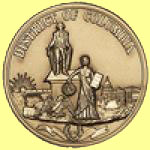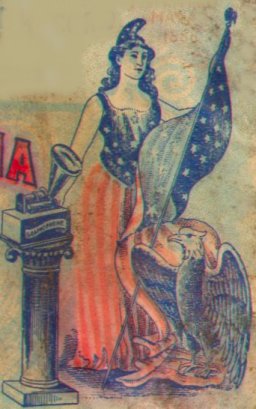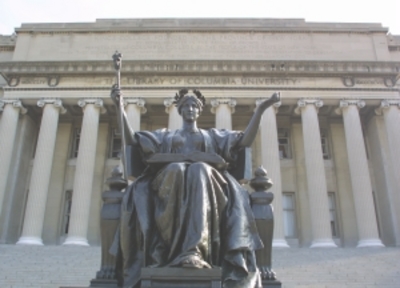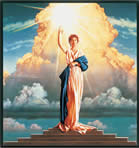New Truths About Columbus
The "mystic, pietistic" signature of Columbus, the famous
.S.
.S. A. S.
X M Y Xpo FERENS.//
is a cipher and has never been de-coded. It never will be until it is placed in its
proper category with the famous "riddle motto" of Frederick the Great: until its
connection with the Order of the Knights Templars is fully explained: until its
points or dots are recognized as the vowels of the Masoretic system: and until
the different forms of the "S" have been understandingly scrutinized.
A superficial examination reveals that by reading the middle line downwards
we obtain S. A. M., which might easily stand for "Society of Ancient Masonry",
and as such possibly prove itself the basis or precursor of that peculiar personification
of America as "Uncle Sam". Many writers have endeavored to read the XMY of the last line
as X for Christ, M for Mary, Y for Joseph or Yoseph. The lame excuse offered is that
Columbus frequently headed his correspondence "In the Name of the Holy Trinity", but
Christ, Mary and Joseph formed the Holy Family and not the Holy Trinity.
A more rational explanation is obtained if the peculiar X as written
by Columbus is accepted as the Hebrew letter Aleph, meaning one, or the Beginning;
and the Y similarly read as the Hebrew letter Yod, with its popular interpretation
of the Sign of the Hand. Bayley assures us that in the Secret Orders M was the accepted
mystic symbol for the Millenium, so the XMY then reads "the beginning of the Millenium
is at hand." This, at least, is in perfect accord with Columbus' Cabalistic "Las Proficias".
The XPO FERENS of the signature deserves profound attention. The usual
attempt to read this as "Christopher" is somewhat silly, although the X quite probably
is the Greek letter Chi or our Ch. When this XPO is written correctly as Columbus wrote
it, with the curve over the P which causes it to be pronounced as B, we really have
CH-B-O, which is by no means to be construed as the English Christopher, or the
Spanish Cristoval, or even the Latin Christophorus. (pp. 30-31)
Who and what then, was Columbus? The grouped evidence from even
the random historical statements far exceeds the accepted belief tha he was of
common peasant stock; and points indubitably to his having been of noble birth.
King Ferdinand would never have endorsed that public acknowledgment of Columbus
as "Conti Roma" if he had not been in actuality, and at very least, a Count. This
also explains that other Royal statement: "the arms you have been accustomed to bear."
All the descriptions we possess of Columbus' personality and character
emphasize that this man was born to blue blood and educated to chivalry. Historians
agree that he was blue or grey-eyed, with golden hair before it turned white, and
of heroic statue; outstanding physical characteristics which are by no means
evidenced by Italian peasantry. (p. 37)
Who was Columbus, this man "spiritually alone, spiritually unapproachable,"
savant, scientist, philosopher and mystic? Marius Andre, one of his harshest critics,
writes: "The son of a poor weaver... gives expressions to the sentiments of a gentleman,
a great Captain, a conqueror of Empires... I ought to be judged as a Captain who has
for so many years borne arms; I ought to be judged by Cavaliers, who for themselves
have won the meed of victory; by Knights of the Sword, and not of title deeds."
Within this statement of Columbus is good circumstantial evidence that he might
have been a member of the great Order of the Golden Fleece, since one perogative
of all its members was the judgment by their peers. This would also account for Columbus
being called "a weaver" or the "son of a weaver", for the Great Guild of Weavers was also
concerned with the weaving of the Golden Fleece. Note the quotation inscribed by this
Guild on the English Town Hall of Hereford:
"We need not sail to Colchis against dragons to prevail,
Or yoke wild bulls to gain the Golden Fleece.
The Golden Fleece will satisfy you heart
Content that the Weavers give."
This Golden Fleece was a purely mystical expression derived from the allegorical
voyage of the Argonauts and closely allied to the Biblical "weaving of the golden
wedding garment"— in other words, the Spirit of man shot through with "that Light
that never was on Sea or Land." It is noteworthy that Columbus usually wore a long
golden chain about his neck, for which he occasionally substituted a chain of amber
beads. This gold chain when shaped or inscribed with the famous S. S. was the insignia
of the Order of the Fleece.
If Columbus was then of high origin, it is obvious that this might have
been the first cause of all the mysteries concerning him, and the one from which all
the others would derive. It should also be apparent that the higher his origin, the
more stringent measures would have been taken lest his real purpose and his true identity
should ever be revealed. Columbus himself must have been fully aware of this and also
of the fact that "Truth crushed to Earth will rise again," when he said, "God is just
and will in due time make known by whom and why it has all been done." (pp. 38-39)
The Columbus Cipher in Shakespeare
— Grace A. Fendler, New Truths About Columbus
L.N. Fowler & Co., London, 1934, 66 pp.
[Stanford Auxilary Library 973.15.C726f]
 DISTRICT OF COLUMBIA SEAL: The statue on the pedestal is of George Washington.
The female figure is of Justice blinded with a wreath in her right hand and a tablet
in her left, on which is written 'Constitution'. To her right is an eagle, a sheaf of
wheat, and agricultural produce. In the background is the Virginia shore with the Potamac
river flowing between Virginia and the city of Washington. To the left is the rising sun
and to the right the Capitol of the United States. The seal was adopted in 1871 as shown
in the wreath with the motto 'Justitia Omnibus'— 'Justice for all'. (p. 57)
DISTRICT OF COLUMBIA SEAL: The statue on the pedestal is of George Washington.
The female figure is of Justice blinded with a wreath in her right hand and a tablet
in her left, on which is written 'Constitution'. To her right is an eagle, a sheaf of
wheat, and agricultural produce. In the background is the Virginia shore with the Potamac
river flowing between Virginia and the city of Washington. To the left is the rising sun
and to the right the Capitol of the United States. The seal was adopted in 1871 as shown
in the wreath with the motto 'Justitia Omnibus'— 'Justice for all'. (p. 57)
The American beauty rose was adopted by the District of Columbia in 1916, but there is
some doubt whether this flower is indigenous to the country as stated in the enactment,
for it may have been introduced from China by way of England. (p. 303)
The woodthrush (Hylocichla mustelina) is regarded unofficially as the emblematic
bird of the District of Columbia, having been selected by the District Federation of
Women's Clubs. (p. 351)
— Arnold Whittick, Symbols: Signs and their Meaning and Uses in Design
LADY COLUMBIA
 Columbia is a poetic and the first popular name for the United States of America.
It was also the origin of the name District of Columbia. The moniker dates from before
the American Revolution in 1776 but fell out of use in the early 20th Century. Exceptions
to this trend include the song Columbia, Gem of the Ocean, still occasionally sung,
and the song Hail, Columbia, an early anthem of the United States now used as the anthem
of the Vice President of the United States. It is still featured as CBS's name, the
Columbia Broadcasting System, Columbia University in New York and Columbia Pictures.
Columbia is a poetic and the first popular name for the United States of America.
It was also the origin of the name District of Columbia. The moniker dates from before
the American Revolution in 1776 but fell out of use in the early 20th Century. Exceptions
to this trend include the song Columbia, Gem of the Ocean, still occasionally sung,
and the song Hail, Columbia, an early anthem of the United States now used as the anthem
of the Vice President of the United States. It is still featured as CBS's name, the
Columbia Broadcasting System, Columbia University in New York and Columbia Pictures.
Advocates for naming the United States "Columbia" continued to press for
the name even after the United States Constitution made the name "United States of America"
official. According to George R. Stewart, the name "United States" was criticized for being
too long, inaccurate, and unpoetic, and that the Constitutional Convention of 1787 would have
been the ideal time to change it. The two people most likely to have argued for a better name,
according to Stewart, were Thomas Jefferson and Benjamin Franklin. But Jefferson was in France
at the time and Franklin was old and "no longer vigorous." Thus the nation remained the
"United States," but popular support for "Columbia" remained and the name was given to
many counties, towns, townships, and "a great river." Just before the Constitutional Convention,
in 1786, South Carolina gave the name "Columbia" to their new capital city.
The proper noun "Columbia" is a name widely used in English derived from that of Christopher Columbus.
Therefore, it was used in a broader sense to refer to the Americas. The term "Pre-Columbian"
refers to the time before the arrival in the Americas of Columbus and other European explorers.
Columbia was also a female national personification of America, similar to the male Uncle Sam,
the British female Britannia and male John Bull, the Italian Italia Turrita and the French Marianne,
often seen in political cartoons through the early 20th Century (see illustration from a Columbia
Records phonograph cylinder package);
the character is still used by Columbia Pictures, though the current incarnation looks very different.
The term Columbian was used to mean "from the USA" and there have been suggestions that
it should be used again as an alternative word for "American", but has not re-entered
general use. The establishment of the nation of Colombia in 1819 resulted in the name
"no longer being available as a national name" for the United States.
(George R. Stewart, Names on the Land, Houghton Mifflin Company, Boston, 1967, p. 173).
COLUMBIA'S UNIVERSITY: ALMA MATER STATUE
 This refers to the statue of the Goddess Minerva (Athena) that has been sitting
on the steps in front of Low Library since 1904, and of which the university
possesses three back-up versions in case of unforeseen rioting or some terrorist attack.
The statue's sculptor is Daniel Chester French who also made the statue of John Harvard
in Harvard Yard. He is said to have been an avid taxidermist who hid an owl in many
of his works. Indeed there is an owl hidden in the folds of Alma Mater's cloak and
college superstition has it that the first member of the incoming class to find
the owl will become class valedictorian.
This refers to the statue of the Goddess Minerva (Athena) that has been sitting
on the steps in front of Low Library since 1904, and of which the university
possesses three back-up versions in case of unforeseen rioting or some terrorist attack.
The statue's sculptor is Daniel Chester French who also made the statue of John Harvard
in Harvard Yard. He is said to have been an avid taxidermist who hid an owl in many
of his works. Indeed there is an owl hidden in the folds of Alma Mater's cloak and
college superstition has it that the first member of the incoming class to find
the owl will become class valedictorian.
SAINT COLUMBA / COLUMCILLE (c. 521-597)
He was born in Donegal of the royal Ui Neill line and was trained as a monk under Saint Finnian
of Moville. He borrowed a copy of Jerome's new translations of the Psalms from the Magh Bile
monastery in order to copy it. The original owners judged that the copy should remain with them
since 'every cow has its calf'. The resulting battle at Cooldrebhne saw Columba as an opponent
in arms, rather than in Christian temperance, and he sent himself into exile from Ireland,
in remorse. He converted many of the Irish settlers in Scotland, as well as King Brude of
the Picts. He founded his monastery on Iona which became in time the burial place and assembly
of Scottish kings. Many monastic settlements sprang from the influence of Iona. Columba, although
he swore never to see Ireland again, returned to champion the social obligations of the Irish in
Scotland to the Irish High Kings. He also arbitrated between the Church and the bards, whose
position was seriously endangered: Irish poets had become feared and hated due to their practice
of satirizing ungenerous patrons (considered in its magical light, since satires could cause
physical effects) and because of their extortionate retainers. Columba was himself a poet
and his arbitration ensured that Irish poets should be allowed to exercise their ancient
function. He is remembered on 9 June [His Feast Day].
— John & Caitlín Matthews, British & Irish Mythology
Diamond Books, London, UK, 1995, pp. 48-49
*************************************
Web Links:
Columbus Historiography Since 1939
by Martin Torodash, The Hispanic American Historical Review, 1966, pp. 409-428
Glossary of Lady Liberty Props
Wikipedia: Columbia
Wikipedia: Columbia Pictures
Wikipedia: Statue of Freedom
Statue of Freedom: U.S. Capitol
Statue of Freedom by Thomas Crawford
Capitol Construction History
Freedom Statue Medallion
Columbia Statue, Hawaii
Albert Pike, Morals and Dogma
Liberty Statue above Speaker's Chair, House of Representatives
Initiation In The Pyramid Of The Dove
Dove in Alchemy & Arthurina Legends
Celtic Christianity: Saint Columba
Catholic Encyclopedia: St. Columba
Patron Saints: St. Columba
Saint Columba (521-597)
Wikipedia: St. Columba
Knights of Columbus
Saint Columba of Iona
SITE
|

![]()
![]()

 DISTRICT OF COLUMBIA SEAL: The statue on the pedestal is of George Washington.
The female figure is of Justice blinded with a wreath in her right hand and a tablet
in her left, on which is written 'Constitution'. To her right is an eagle, a sheaf of
wheat, and agricultural produce. In the background is the Virginia shore with the Potamac
river flowing between Virginia and the city of Washington. To the left is the rising sun
and to the right the Capitol of the United States. The seal was adopted in 1871 as shown
in the wreath with the motto 'Justitia Omnibus'— 'Justice for all'. (p. 57)
DISTRICT OF COLUMBIA SEAL: The statue on the pedestal is of George Washington.
The female figure is of Justice blinded with a wreath in her right hand and a tablet
in her left, on which is written 'Constitution'. To her right is an eagle, a sheaf of
wheat, and agricultural produce. In the background is the Virginia shore with the Potamac
river flowing between Virginia and the city of Washington. To the left is the rising sun
and to the right the Capitol of the United States. The seal was adopted in 1871 as shown
in the wreath with the motto 'Justitia Omnibus'— 'Justice for all'. (p. 57)

